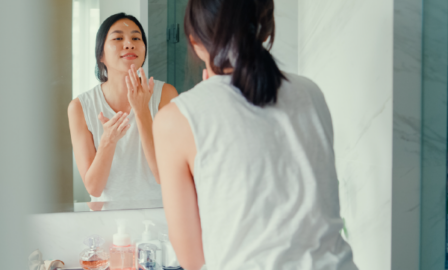The (Continued) Rise of the Skinfluencer
Over the course of the last 5 years, the prevalence of social media influencers has grown exponentially. Brands across the consumer products and retail industries are tapping into influencer as an entire marketing channel, where the influencers serve as an authentic third-party endorser – often one with a dedicated following. Beauty and fashion influencers worldwide continue to lead numerically, making up 19.2% of Instagram influencers. So-called skinfluencers have become particularly influential in the skincare and beauty space, particularly as skincare has risen to the forefront of consumers’ minds throughout the COVID-19 pandemic.
Skinfluencers are not only providing consumers with advice and direction on creating a skincare routine or trying a new product, they’re helping consumers better understand the science behind skincare and navigate the diverse array of products available. As consumers have become hyper-focused on skincare, with U.S. sales of skincare growing by 13% compared to makeup’s growth of 1% since last year, the environment has ripened for skinfluencers. The weight that skinfluencers carry is especially critical to consider when mastering successful marketing and producing better products in the skincare industry.
Social Media in 2021
Skinfluencers are driving up views and gaining followers across nearly all social media platforms. In the past year alone, skincare and beauty received 33 billion hashtag views worldwide on TikTok. Each influencers brings a unique perspective and approach to how they engage their audience, both depending on their platform and target audience.
Historically speaking, most influencers got their start on YouTube where content creators are able to upload longer, more in-depth videos. Skinfluencers have leveraged the digital real estate to dive deep into the science behind skin while explaining how different brands’ products will affect the natural chemistry of an individual’s skin. Liah Yoo and Cassandra Bankson are two of the most popular skinfluencers on YouTube. Yoo, a Korean-based influencer with nearly 2 million subscribers, focuses her content on her own routine, skincare reviews, and calling out ineffective products. With just over 1.5 million subscribers, Bankson focuses her content on the science behind skincare and cruelty-free makeup products. For brands, YouTube is an ideal platform to partner with an influencer and provide transparent, exhaustive information detailing product ingredients, benefits, interactions, and more.
Given it’s viral nature, TikTok is ideal for reaching a broad audience and discovering new customers via the video sharing tool’s well-publicized algorithm. One of the most well-known TikTok skinfluencers is Hyram Yarbro, known online as @skincarebyhyram. Yarbro, who got his start on YouTube, shares his opinion on products and love for affordable skincare with his 6.8 million followers. Skinfluencers like Yarbro have been famously successful in generating sharp spikes in website traffic, followers, and ultimately, sales for many brands. Skincare brand eos, for example, saw a 35x increase in traffic from TikTok to its website following a viral TikTok featuring one of their products.
TikTok allows brands to highlight their products in a quick and concise manner, generating an increase in overall awareness among users. Instagram, on the other hand, provides more targeted sales and advertising capabilities than any other platform as the commerce side is much more evolved. Two well-known Instagram skinfluencers are Dr. Shereene Idriss, @shereeneidriss, and Jake Jamie Ahmad, @jakejamie. Dr. Idriss, a board-certified dermatologist, has over 338K followers and uses the platform to put an end to misinformation about skincare. Jamie is a British influencers who focuses his content on product reviews and DIY skincare. Skinfluencers and brands alike can use Instagram as a key marketing tool to promote and sell products, especially through the Shop feature.
In a 2019 survey, 28% of U.S. respondents placed social media as their top influence when purchasing skincare products. Skinfluencers have grown increasingly impactful when it comes to how brands market, design, and manufacture their products. Keep in mind that in their role, these influencers aren’t merely testing a product’s efficacy, they’re reviewing the consumer experience as a whole and pushing for changes to labeling and sourcing in a bid for greater transparency.
Leveraging Skinfluencers
According to recent studies, micro-influencers and macro-influencers respectively yield 45.8% and 33.6% effectiveness. Skinfluencers come from a wide variety of backgrounds with some having formal medical training and licensure while others are merely enthusiasts. Some choose to focus on overall skin health while others target their content to a specific segment of the population or area of skin care. It’s most critically important to ensure that your skincare brand chooses a partner with the values and ideals that fit your brand. A mismatched partnership will only yield negative results for all parties so engaging a skinfluencer closely aligned to your brand is critical.
Once a partner has been selected, there are a range of tactics brands leverage with a skinfluencer, including:
- Giveaways
- Discount Codes
- Product Reviews
- Sponsored Hauls
A number of skincare businesses have even partnered with skinfluencers to create product lines of their own. Recently, TikTok’s Hyram Yarbro partnered with The Inkey List to create his own skincare line, Selfless by Hyram. As other skinfluencers are likely to explore creating their own line in the future, a brand partnership allows for the necessary infrastructure and consumer reach needed to create a successful launch. Brands can partner with influencers to market to specific niches across platforms, potentially even attracting new audiences altogether. Brands that work with influencers that align with their values and compliment their image will gain an honest and believable partnership, persuading consumers to explore the brand for themselves.
Subscribe to Clarkston's Insights
Contributions by Rachel Ruth



